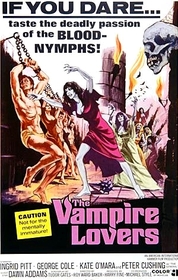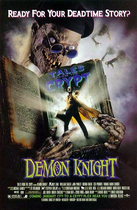Our editor-in-chief Nate Yapp is proud to have contributed to the new book Hidden Horror: A Celebration of 101 Underrated and Overlooked Fright Flicks, edited by Aaron Christensen. Another contributors include Anthony Timpone, B.J. Colangelo, Dave Alexander, Classic-Horror.com's own Robert C. Ring and John W. Bowen. Pick up a copy today from Amazon.com!
The Vampire Lovers (1970)
The Vampire Lovers, while based on nineteenth century writer Sheridan LeFanu’s classic vampire novella "Carmilla," is not high art. It is however, a highly enjoyable if a little tawdry vampire yarn in the grand Hammer tradition replete with foggy graveyards, ruined castles, buxom, braless, neck-biting beauties and the greatest vampire killer of all time, Peter Cushing.
In Styria, a province of Austria, General Spielsdorf (Cushing) invites a beautiful but mysterious and lovely young girl name Marcilla (the voluptuous and sultry Ingrid Pitt) to stay with he and his niece Laura (Pippa Steele). Marcilla’s “mother” is called away for an emergency and cannot take her daughter, or so she says. As Laura develops an intimate friendship with Marcilla, she falls ill and begins to suffer nightmares in which she is attacked in her bed by a shadowy feline beast. Upsettingly, the nightmares also contain visions of Marcilla. As Laura’s health declines, the General begins to suspect something is afoul with his strange houseguest and he quietly wishes her visit to cease.
On the evening which Laura’s health takes a final dire turn, Marcilla vanishes. Upon post-mortem inspection by the Doctor, two puncture wounds are found in Laura’s breast.
In another nearby part of Styria, the mysterious and lovely girl reappears to a local landholder, Roger Morton (George Cole) and his daughter Emma (The pixie-ish yet buxom Madeline Smith). With a similar story to the one told the General, the girl, this time called Carmilla by her ”mother,” is invited to stay with the Mortons until her mother’s return. Emma’s health also begins to falter just as her relationship with Carmilla grows deeper. Soon, deaths begin to accumulate in the province and evil is suspected.
There is little mystery as to what is going on in Styria or The Vampire Lovers. Nothing is hidden either about the plot or about the figures of the female cast. In fact, in this vampire film bloodletting plays second fiddle to heaving bosoms. Director Roy Ward Baker (Quartermass and the Pit, Legend of the 7 Golden Vampires, Scars of Dracula) and screenwriter Tudor Gates (Twins of Evil, Lust for a Vampire, Barbarella) only loosely base their film on Sheridan LeFanu’s original novella. The book had only mild homoerotic undertones, but Baker and Gates deliver full blown nude lesbian … well let’s say they got to second base and home plate was in pretty clear sight. Vampires had never been more abashedly sexual than Ingrid Pitt. The seductive qualities of film vampires have almost been a given since Bela Lugosi and his trio of beguiling but ghoulish gals pals graced the screen in 1931, but the sexual revolution had come to fruition in The Vampire Lovers’ year of release (1970) and it was only a matter of time before vampires got to experience a little free love of their own.
With a budget higher than many of its Hammer or AIP sister films of the time, the film boasts excellent production values. All of the familiar Hammer trimmings are present, polished and looking as good as they ever did. The visuals are lush, gothic and richly toned. Unfortunately the performances in the film range from stilted in some of the Carmilla, Emma/Laura scenes to quite good from the veteran Peter Cushing. Cushing is unfortunately given too little to do in this film. His presence could have infused much needed vitality into a movie which sometimes seems to be afflicted with the same energy-draining malady its ingénues suffer from. But more time for Cushing would have meant less time for the real stars, Pitt, Steele, Smith and their cleavage.
Two other films in what’s known as the Karnstein trilogy (the family name of our vampire Pitt) followed the bare breasts and blood drinkers formula to some better and some only so-so moments. Twins of Evil (featuring Cushing) is considered one of the best of Hammer’s later films and Lust for a Vampire (featuring Pippa Steele) has been called by far their most sexual film (Lust had to be cut 7 minutes to receive and “R” rating in America). Neither film however, follows LeFanu’s book Carmilla as closely as The Vampire Lovers, nor do they have Ingrid Pitt (rowr-rowr). The Vampire Lovers, for numerous and varying reasons, has earned a prized place amongst the Hammer Classics. Whether you want to see prime examples of undulating womanhood, atmospheric Hammer Gothicism or both, The Vampire Lovers is a great film to watch or add to your collection.








